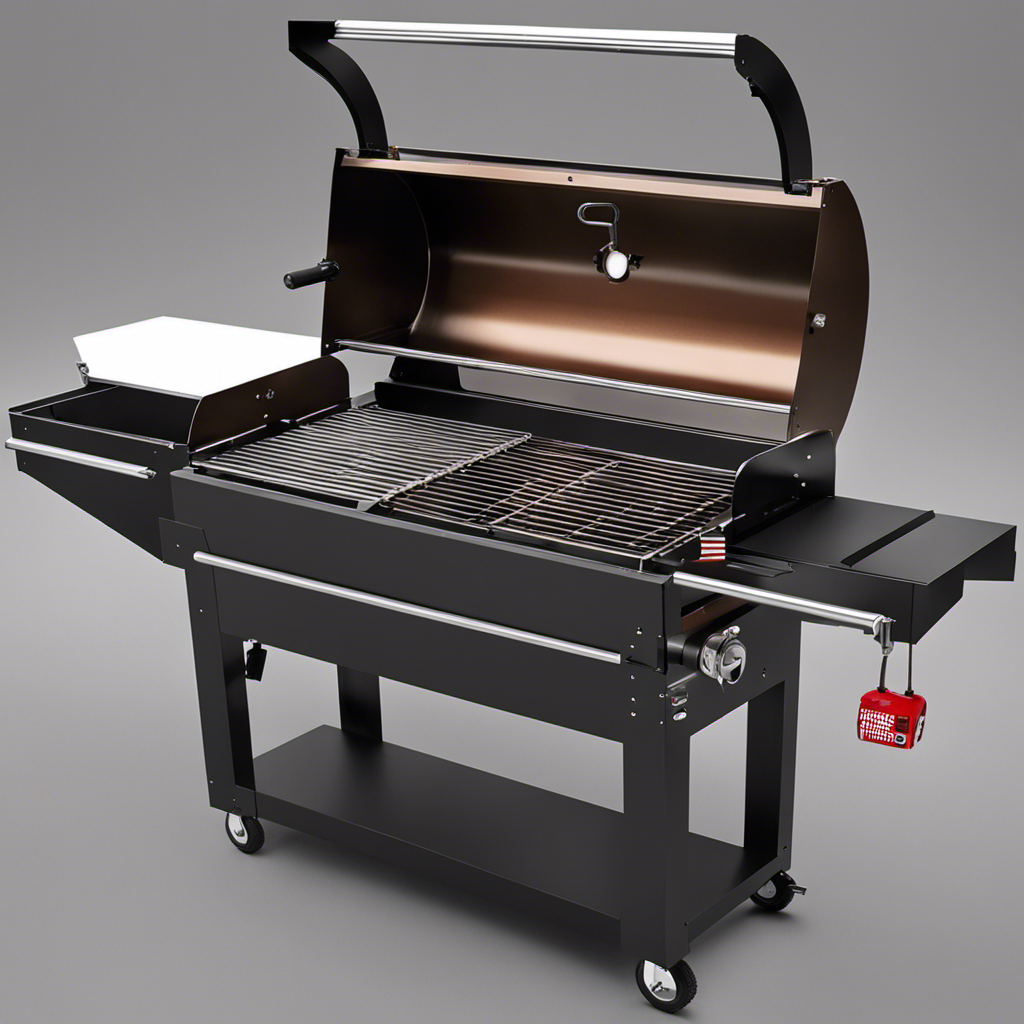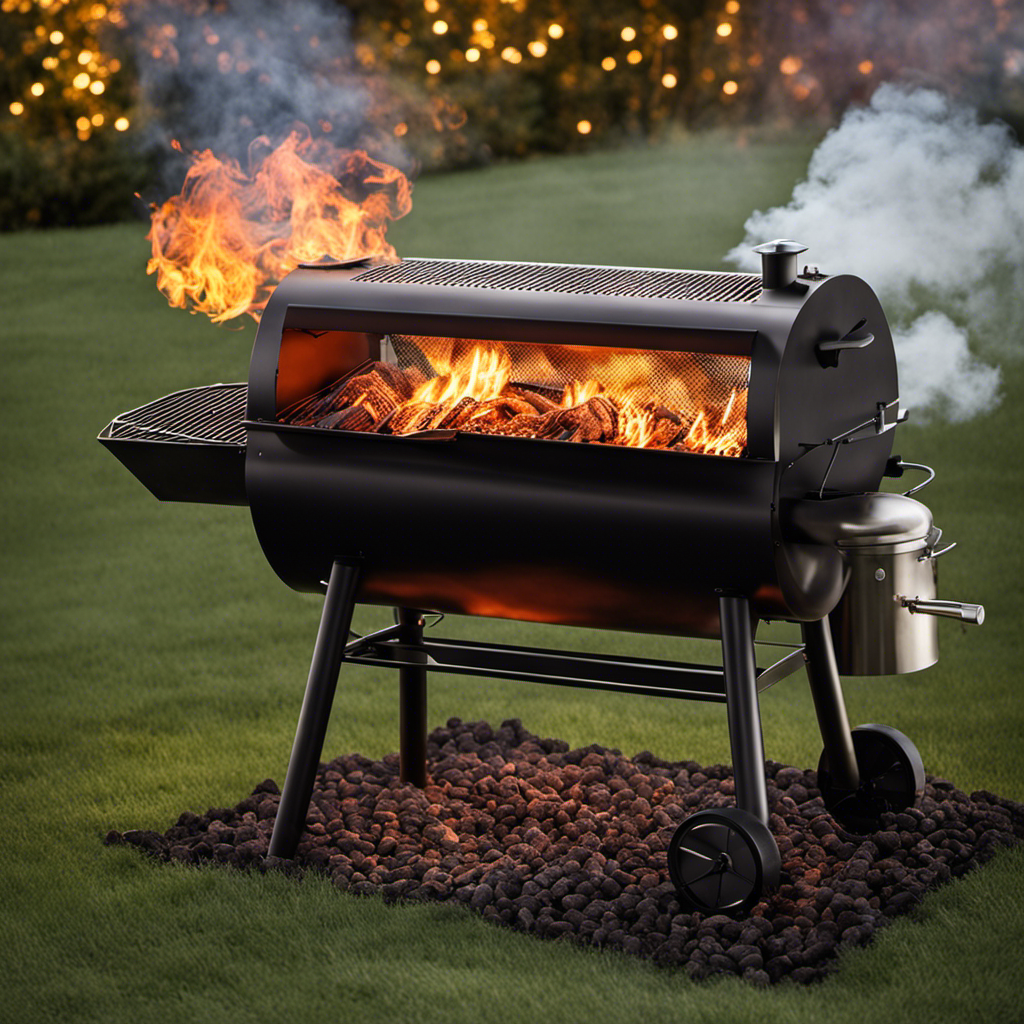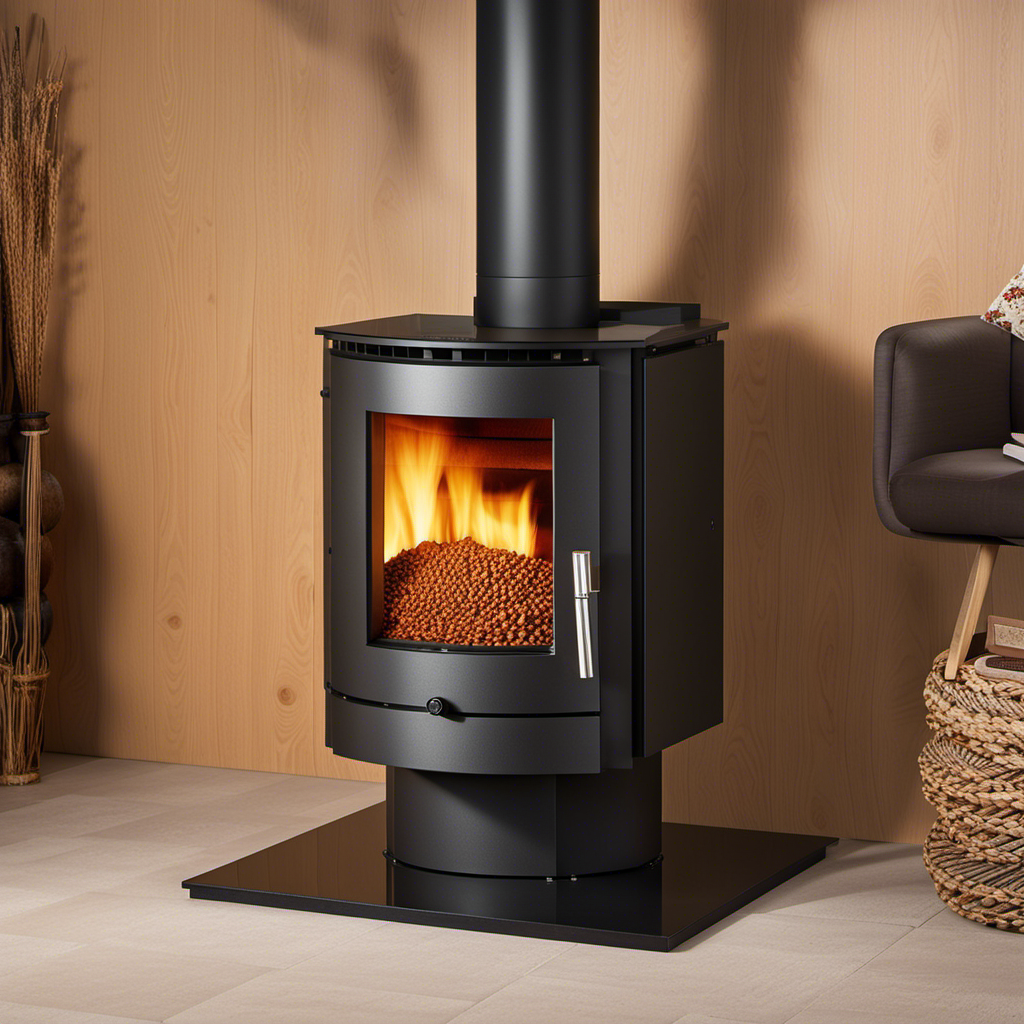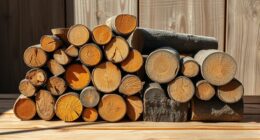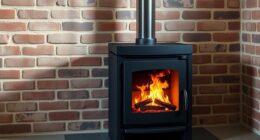Did you know that it’s possible to convert grass into premium-quality wood pellets for use as fuel? In this article, I’ll walk you through how to create wood pellets from grass, equipping you with the essential equipment and methods needed for a successful conversion.
With a focus on achieving top-notch quality and exploring the environmental benefits, you’ll learn how to produce sustainable fuel alternatives.
So, let’s dive into the world of grass pelletization and discover the potential it holds.
Key Takeaways
- Switchgrass and miscanthus are highly productive perennial grasses suitable for wood pellet production.
- Pellet mill, hammer mill, and pellet cooler are essential tools for wood pellet production.
- Grass moisture levels need to be monitored and maintained for optimal pellet production.
- Grass pellets are renewable and sustainable, reducing dependence on non-renewable energy sources.
Types of Grass Suitable for Making Wood Pellets
You can use various types of grass to make wood pellets, such as switchgrass or miscanthus. When it comes to selecting the right grass species for pellet production, it is important to consider their characteristics and suitability for the process.
Switchgrass, for example, is a perennial grass that is highly productive and can grow in a variety of environmental conditions. It has a high cellulose content, making it an ideal candidate for wood pellet production.
Miscanthus, on the other hand, is known for its rapid growth and high biomass yield. Both of these grass species can be cultivated on marginal lands, minimizing competition with food crops. Incorporating these types of grass into the pellet production process can help maximize biomass utilization and contribute to a sustainable energy future.
To move forward with wood pellet production, it is essential to have the necessary equipment and tools.
Equipment and Tools Needed for Wood Pellet Production
The equipment and tools needed for wood pellet production include a pellet mill, hammer mill, and a pellet cooler. These tools are essential in the pelletizing process, which involves compressing the grass into dense pellets that can be used as a renewable energy source.
The pellet mill is responsible for shaping the grass into pellets by applying pressure and heat. The hammer mill, on the other hand, is used to grind the grass into smaller particles before it goes into the pellet mill. Lastly, the pellet cooler helps in cooling down the pellets and removing any excess moisture.
These pelletizing techniques have gained significant popularity in recent years due to the growing demand for renewable energy sources. In fact, the grass pellet market has witnessed substantial growth, making it a promising industry to invest in.
To prepare the grass for pelletization, various steps need to be followed.
Preparing the Grass for Pelletization
When it comes to preparing grass for pelletization, there are three key factors to consider: grass moisture levels, reducing grass volume, and achieving the optimal grass particle size.
Properly managing grass moisture levels is crucial to ensure the efficiency and quality of the pelletization process.
Additionally, reducing grass volume through drying and compacting techniques can improve the overall productivity of the pelletization system.
Grass Moisture Levels
To ensure optimal wood pellet production from grass, it’s important to monitor and maintain proper moisture levels. This is crucial because grass with high moisture content can lead to poor pellet quality, increased energy consumption during drying, and decreased overall production efficiency.
Grass drying techniques such as using natural sunlight, forced air drying, or mechanical drying can be employed to reduce moisture content. These techniques should be chosen based on the specific requirements of the grass pellet market demand and the available resources.
By carefully controlling the moisture levels, we can ensure that the grass is in an ideal condition for pelletization, resulting in high-quality pellets with consistent performance.
Now, let’s move on to the next section and discuss how we can reduce the volume of grass for more efficient processing.
Reducing Grass Volume
You can achieve more efficient processing by reducing the volume of the grass. This step is crucial in grass pellet production as it allows for better compression and higher pellet density. Here are some key points to consider:
- Chopping the grass into smaller pieces using a grass cutter or shredder can significantly reduce the overall volume.
- Drying the grass to the optimal moisture level before pelletizing ensures better pellet quality and reduces the risk of mold or decay.
- Removing any impurities or foreign objects from the grass, such as stones or twigs, improves the overall pellet production process.
- Using a hammer mill or grinder can further reduce the grass volume, making it easier to handle and process.
- Compacting the grass into pellets using a pellet mill or briquette machine increases the energy density and facilitates storage and transportation.
Optimal Grass Particle Size
Chopping the grass into smaller pieces allows for better compression and higher pellet density in grass pellet production. Research has shown that the optimal grass particle size for pelletizing is around 3-5mm. This size range ensures that the grass can be easily compressed and forms dense pellets with minimal void spaces. To illustrate the importance of particle size, here is a table showcasing the effect of different particle sizes on grass pellet density:
| Particle Size (mm) | Grass Pellet Density (g/cm³) |
|---|---|
| 2 | 0.72 |
| 4 | 0.78 |
| 6 | 0.65 |
As the table demonstrates, a particle size of 4mm yields the highest grass pellet density. Additionally, maintaining optimal grass moisture during the pelletizing process is crucial to achieve desired pellet density. Controlling the moisture content within the range of 10-15% ensures better pellet formation and higher density. This information sets the foundation for understanding the process of pelletizing grass into wood pellets, which will be discussed in the following section.
The Process of Pelletizing Grass Into Wood Pellets
As I delve into the process of pelletizing grass into wood pellets, it is essential to understand the benefits that come with using grass pellets as a fuel source.
Not only are grass pellets a renewable energy alternative, but they also have a lower carbon footprint compared to traditional fossil fuels.
To effectively pelletize grass, certain equipment is required. This includes a pellet mill, a hammer mill, and a dryer, which work together to convert the raw grass material into compact and efficient pellets.
Benefits of Grass Pellets
When using grass pellets, you’ll discover numerous benefits. Here are three key advantages of grass pellet fuel:
-
Renewable and Sustainable: Grass pellets are made from a readily available and renewable resource – grass. This makes them a sustainable alternative to fossil fuels and reduces our dependence on non-renewable energy sources.
-
Environmentally Friendly: Grass pellets have a lower carbon footprint compared to traditional fossil fuels. When burned, they release fewer greenhouse gas emissions, contributing to a cleaner and healthier environment.
-
Cost-effective: Grass pellets are cost-effective compared to other heating options. They are readily available and can be produced locally, reducing transportation costs. Additionally, grass pellets have a higher energy density than raw grass, resulting in increased heating efficiency.
With these benefits in mind, let’s now transition to the section on the pelletizing equipment needed for the grass pellet production process.
Pelletizing Equipment Needed
To produce grass pellets, you’ll need specialized equipment. Pelletizing techniques require machinery that can efficiently process the grass into small pellets. In the grass pellet market analysis, it is crucial to consider the type and quality of equipment used to ensure the production of high-quality pellets. Here is a table outlining the essential equipment for grass pellet production:
| Equipment | Function | Example Brand |
|---|---|---|
| Hammer Mill | Size reduction | Bliss |
| Pellet Mill | Pellet formation | CPM |
| Cooler | Cooling pellets | Andritz |
| Packaging Line | Packaging | Premier Tech |
These brands are reputable and widely used in the industry, ensuring reliable performance and consistent pellet quality. By investing in the right equipment, one can optimize the efficiency and productivity of grass-to-pellet conversion. Considering the equipment’s capabilities and technical specifications is vital for successful grass pellet production. In the following section, we will discuss the factors to consider for efficient grass-to-pellet conversion, building upon the equipment discussed here.
Factors to Consider for Efficient Grass-to-Pellet Conversion
If you want to efficiently convert grass to pellets, there are certain factors you should consider. Here are three important factors to take into account when making grass pellets:
-
Moisture Content: Ensuring the proper moisture content is crucial for pelletizing grass. The ideal moisture range for grass pellets is between 10% and 20%. Higher moisture content can lead to clumping and poor pellet quality, while lower moisture content can result in excessive dust and decreased pellet density.
-
Particle Size: The size of the grass particles plays a significant role in pellet production. It is recommended to grind the grass into smaller particles, typically around 3-5mm in diameter. This allows for better compression and binding during the pelletizing process, resulting in higher quality pellets.
-
Additives: Adding binders or additives to the grass can improve the pelletizing process and enhance the pellet quality. Binders help to improve the pellet’s durability and prevent disintegration during handling and storage.
Considering these factors will help you achieve the desired results when converting grass to pellets. By optimizing moisture content, particle size, and incorporating appropriate additives, you can produce high-quality grass pellets that offer the benefits of reduced emissions, improved energy efficiency, and sustainable fuel source.
Now, let’s move on to the next section and explore tips for achieving high-quality wood pellets from grass.
Tips for Achieving High-Quality Wood Pellets From Grass
For optimal results, ensure that you maintain the appropriate moisture content, particle size, and incorporate suitable additives when converting grass into high-quality pellets.
When it comes to the types of grass suitable for pelletization, it is important to choose grasses with high cellulose and hemicellulose content, such as switchgrass and miscanthus. These grasses have been found to produce pellets with excellent combustion properties.
To determine the moisture levels of the grass, various techniques can be employed, including the oven-drying method and the use of moisture meters. These methods provide accurate measurements and help ensure that the grass is dried to the ideal moisture content for pellet production.
When storing and handling grass pellets, it is essential to maintain proper temperature and humidity conditions to prevent degradation and maintain pellet quality.
Storing and Handling Grass Pellets
Ensure you maintain proper temperature and humidity conditions when storing and handling your grass pellets to prevent degradation and maintain their quality. Storing grass pellets requires a controlled environment to ensure their longevity.
The ideal temperature for storage ranges from 10°C to 20°C, while the relative humidity should be kept between 40% and 50%. These conditions prevent moisture absorption, which can lead to mold growth and degradation of the pellets. It is important to store the pellets in a dry area, away from direct sunlight and sources of heat.
When handling grass pellets, it is crucial to avoid excessive roughness or impact, as this can cause the pellets to break. Additionally, using proper handling equipment, such as pallet jacks or forklifts, can minimize the risk of damage during transportation.
By adhering to these guidelines, you can ensure the quality and longevity of your stored grass pellets.
Transitioning into the subsequent section about comparing grass pellets to traditional wood pellets, it is essential to understand the unique characteristics and benefits of each fuel source.
Comparing Grass Pellets to Traditional Wood Pellets
In comparing grass pellets to traditional wood pellets, there are several important factors to consider: cost and environmental impact. Let’s take a closer look at how grass pellets stack up against their wood counterparts.
| Factor | Grass Pellets | Wood Pellets |
|---|---|---|
| Cost | Lower cost due to abundant raw material and less processing | Higher cost due to limited availability and processing requirements |
| Environmental Impact | Lower carbon emissions and reduced deforestation | Higher carbon emissions and deforestation due to sourcing from trees |
When it comes to cost, grass pellets have a clear advantage. With an abundant raw material and less processing requirements, the production costs are significantly lower compared to wood pellets, which rely on limited availability and require more processing.
From an environmental standpoint, grass pellets also come out on top. They result in lower carbon emissions and reduced deforestation compared to wood pellets, which contribute to higher carbon emissions and deforestation due to the sourcing of trees.
Considering both cost and environmental impact, grass pellets are a promising alternative to traditional wood pellets. Now, let’s delve into the environmental benefits of using grass pellets as fuel.
Environmental Benefits of Using Grass Pellets as Fuel
When using grass pellets as fuel, you’ll notice a significant reduction in carbon emissions and deforestation compared to traditional wood pellets. Grass pellets offer several advantages over wood pellets, making them a more sustainable and environmentally friendly option.
-
Lower carbon emissions:
-
Grass pellets produce fewer greenhouse gases during combustion, resulting in a smaller carbon footprint.
-
Grasses grow quickly and absorb more carbon dioxide during their growth cycle, further offsetting emissions.
-
Reduced deforestation:
-
Harvesting grasses for pellet production avoids the need for cutting down trees, preserving natural forests and habitats.
-
Grasses can be grown on marginal lands, reducing the pressure on valuable agricultural land.
However, there are challenges in grass pellet production that need to be addressed, such as:
- Efficient harvesting and processing methods to ensure high pellet quality.
- Developing robust supply chains to ensure consistent availability of grass feedstock.
- Addressing the potential impact of grass pellet production on water resources and soil health.
Overall, the use of grass pellets as fuel offers significant environmental benefits, but further research and investment are needed to overcome production challenges and maximize their potential.
Frequently Asked Questions
Can Any Type of Grass Be Used for Making Wood Pellets?
Yes, any type of grass can be used for making wood pellets. Grass pellets have numerous benefits, such as high energy density and low emissions. However, certain grass types like switchgrass and miscanthus are considered best for pellet production due to their high cellulose content.
What Are the Safety Precautions to Take When Using the Equipment and Tools for Wood Pellet Production?
When it comes to equipment safety and tool precautions, I prioritize the well-being of my team. We follow strict protocols, ensuring proper training, regular maintenance, and the use of protective gear to minimize risks and accidents.
How Long Does It Take to Prepare the Grass for Pelletization?
To prepare grass for pelletization, the preparation time depends on several factors, such as the moisture content of the grass and the type of equipment used. The pelletization process typically takes a few hours to complete.
Are There Any Specific Factors That Can Affect the Efficiency of Grass-To-Pellet Conversion?
Factors such as moisture content, grass species, and particle size can significantly impact the efficiency of grass-to-pellet conversion. Properly controlling these variables is crucial for achieving optimal pelletization results and maximizing the overall efficiency of the process.
Can Grass Pellets Be Used in the Same Way as Traditional Wood Pellets in Terms of Storage and Handling?
Grass pellets can be stored and handled similarly to traditional wood pellets. They have similar characteristics and can be stored in bulk or in bags, making them convenient for use in biomass heating systems.
Can the Same Process Used to Make Wood Pellets be Applied to Grass?
Yes, the making wood pellet technique can be applied to grass to produce grass pellets. By using a similar process of grinding, drying, and compressing, grass can be transformed into pellets for use as a renewable energy source. This method holds promise for sustainable energy production from a variety of organic materials.
Conclusion
In conclusion, the process of making wood pellets from grass can be a viable and sustainable alternative to traditional wood pellets.
Through careful selection of suitable grass types and the use of specialized equipment, it is possible to convert grass into high-quality pellets efficiently.
One interesting statistic to note is that grass pellets have been found to have a higher heating value compared to traditional wood pellets, with an average heating value of 8,000 to 9,000 BTU per pound.
This makes grass pellets a highly efficient and environmentally friendly fuel option.
Growing up surrounded by the vast beauty of nature, Sierra was always drawn to the call of the wild. While others sought the comfort of the familiar, she ventured out, embracing the unpredictable and finding stories in the heartbeat of nature.
At the epicenter of every remarkable venture lies a dynamic team—a fusion of diverse talents, visions, and passions. The essence of Best Small Wood Stoves is crafted and refined by such a trio: Sierra, Logan, and Terra. Their collective expertise has transformed the platform into a leading authority on small wood stoves, radiating warmth and knowledge in equal measure.


